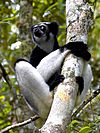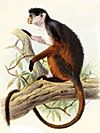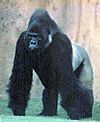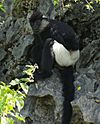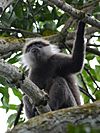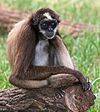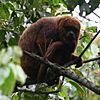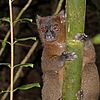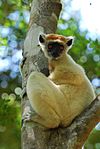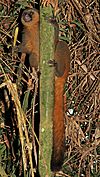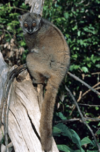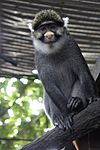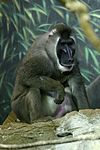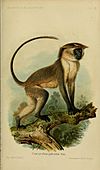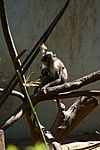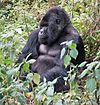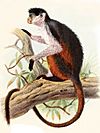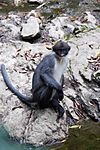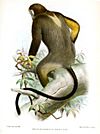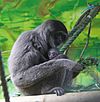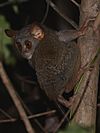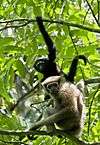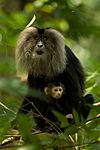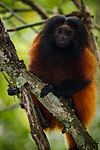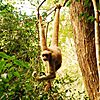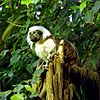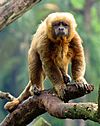The World's 25 Most Endangered Primates facts for kids
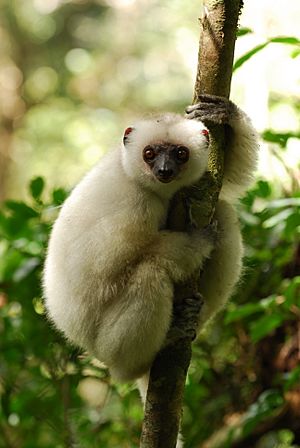
The World's 25 Most Endangered Primates is a special list of primate species that are in great danger of disappearing forever. This list is put together by several important groups that work to protect animals, like the International Union for Conservation of Nature (IUCN) and the International Primatological Society (IPS). The list started in 2000 to help people notice which primates needed the most help. Since 2004, the list has been called "Primates in Peril: The World's 25 Most Endangered Primates."
Every two years, experts update the list. They add new information about each species, including how many are left and what dangers they face. Many experts from around the world help write these reports.
The 25 species on the 2018–2020 list live in 32 different countries. Madagascar has the most species on the list with five. Indonesia, Brazil, Ghana, and Cote d'Ivoire each have three. The list divides these primates into four main areas: Madagascar, Africa, Asia (including Indonesian islands), and the Americas (Central and South America).
The main goal of this list is to show everyone which primates are most at risk. It also encourages governments and other groups to find ways to protect these animals. Primates are chosen for the list if there are very few of them left or if their numbers are dropping very quickly. The biggest problems for primates are losing their homes and being hunted.
Some specific threats include:
- Losing their habitat because forests are cut down for farming, ranching, making charcoal, or getting firewood.
- Illegal logging and mining.
- Forests becoming broken up into smaller pieces.
- Being caught alive for the exotic pet trade.
- Being hunted for bushmeat (meat from wild animals) or for traditional medicine.
Sometimes, species are removed from the list. This doesn't always mean they are safe. It can mean that other species now need more attention because their future looks even worse.
Contents
Understanding the List
This section helps you understand the tables below.
| Species | This column shows the common and scientific name of the primate. |
|---|---|
| Years listed | This tells you how many years the species has been on the "Top 25 Most Endangered Primates" list. |
| Location(s) | This shows the countries where the primate can be found. |
| Estimated population | This is the most recent guess of how many of these animals are left in the wild. |
| IUCN status | This shows how endangered the species is, according to the IUCN. |
| Threats | This lists the dangers that the species faces. |
Primates on the Current List (2018–2020)
Here are some of the primates that are currently on the list of the world's most endangered.
| Species | Years listed | Location(s) | Estimated population | IUCN status | Threats |
|---|---|---|---|---|---|
| Bemanasy mouse lemur Microcebus manitatra |
2018 | Madagascar | unknown | Critically Endangered |
|
|
Lac Alaotra bamboo lemur Hapalemur alaotrensis |
2000 2014 2016 2018 |
Madagascar | 2,500 (2018 estimate) |
Critically Endangered |
|
| James' sportive lemur Lepilemur jamesorum |
2016 2018 |
Madagascar | 1,386 (2010 estimate) |
Critically Endangered |
|
|
Indri Indri indri |
2012 2018 |
Madagascar | unknown | Critically Endangered |
|
|
Aye-aye Daubentonia madagascariensis |
2016 2018 |
Madagascar | unknown | Endangered |
|
| Species | Years listed | Location(s) | Estimated population | IUCN status | Threats |
|---|---|---|---|---|---|
| Rondo dwarf galago Galagoides rondoensis |
2006 2008 2010 2012 |
Tanzania | unknown | Critically Endangered |
|
|
Roloway monkey Cercopithecus roloway |
2002 2006 2008 2010 2012 |
Côte d'Ivoire Ghana |
unknown | Endangered |
|
| Tana River red colobus Procolobus rufomitratus |
2002 2004 2006 2008 2012 |
Kenya | 1,100–1,300 | Endangered |
|
|
Bioko red colobus Piliocolobus pennantii pennantii |
2004 2006 2010 2012 |
Equatorial Guinea (Bioko Island) | fewer than 5,000 | Endangered |
|
|
Eastern lowland gorilla Gorilla beringei graueri |
2010 2012 |
Democratic Republic of the Congo | 5,000 | Critically Endangered |
|
| Species | Years listed | Location(s) | Estimated population | IUCN status | Threats |
|---|---|---|---|---|---|
|
Javan slow loris Nycticebus javanicus |
2008 2010 2012 |
Indonesia (Java) | unknown | Critically Endangered |
|
| Pig-tailed langur Simias concolor |
2002 2004 2006 2008 2010 2012 |
Indonesia (Mentawai Islands) | 700–3,347 | Critically Endangered |
|
|
Delacour's langur Trachypithecus delacouri |
2000 2002 2004 2006 2008 2010 2012 |
Vietnam | fewer than 250 | Critically Endangered |
|
|
Golden-headed langur Trachypithecus poliocephalus |
2000 2002 2004 2006 2008 2010 2012 |
Vietnam | 60–70 | Critically Endangered |
|
|
Western purple-faced langur Semnopithecus vetulus nestor |
2004 2006 2008 2010 2012 |
Sri Lanka | unknown | Critically Endangered |
|
|
Grey-shanked douc Pygathrix cinerea |
2000 2002 2004 2006 2008 2010 2012 |
Vietnam | 600–700 | Critically Endangered |
|
|
Tonkin snub-nosed monkey Rhinopithecus avunculus |
2000 2002 2004 2006 2008 2010 2012 |
Vietnam | 200–250 | Critically Endangered |
|
| Eastern black crested gibbon Nomascus nasutus |
2008 2010 2012 |
China Vietnam |
around 110 | Critically Endangered |
|
| Pygmy tarsier Tarsius pumilus |
2012 | Indonesia (Sulawesi) | unknown | Data deficient |
|
| Species | Years listed | Location(s) | Estimated population | IUCN status | Threats |
|---|---|---|---|---|---|
|
Brown spider monkey Ateles hybridus |
2004 2006 2008 2010 2012 |
Colombia Venezuela |
unknown | Critically Endangered |
|
| Brown-headed spider monkey Ateles fusciceps fusciceps |
2006 2012 |
Ecuador | unknown | Critically Endangered |
|
| Kaapori capuchin Cebus kaapori |
2012 | Brazil | unknown | Critically Endangered |
|
| Rio Mayo titi Callicebus oenanthe |
2012 | Peru | unknown | Critically Endangered |
|
|
Northern brown howler Alouatta guariba guariba |
2012 | Brazil | fewer than 250 | Critically Endangered |
|
Primates Formerly on the List
Over time, species are added or removed from the list. Sometimes, a species is removed because conservation efforts have helped it. For example, the black lion tamarin and golden lion tamarin were removed in 2006–2008 because they were doing better. These animals still have small populations, but people are working hard to protect them.
However, not all species are removed because their situation improved. Sometimes, new species are added to bring attention to other animals that are also in great danger. For instance, the Javan slow loris replaced another loris species to highlight the severe threats it faces from the pet trade and traditional medicine.
| Species | Years listed | Location(s) | Estimated population | IUCN status | Threats |
|---|---|---|---|---|---|
|
Greater bamboo lemur Prolemur simus |
2002 2004 2006 2008 2010 |
Madagascar | 500 or fewer | Critically Endangered |
|
|
Black-and-white ruffed lemur Varecia variegata |
2010 | Madagascar | unknown | Critically Endangered |
|
|
Gray-headed lemur Eulemur cinereiceps |
2004 2006 2008 |
Madagascar | 7,265 ± 2,268 | Endangered |
|
|
Golden-crowned sifaka Propithecus tattersalli |
2000 | Madagascar | 6,000–10,000 | Endangered |
|
|
Golden bamboo lemur Hapalemur aureus |
2000 | Madagascar | fewer than 5,916 | Endangered |
|
|
Sahamalaza sportive lemur Lepilemur sahamalazensis |
2006 | Madagascar | unknown | Data deficient |
|
|
Perrier's sifaka Propithecus perrieri |
2000 2002 2004 2014 2016 |
Madagascar | around 915 | Critically Endangered |
|
|
Blue-eyed black lemur Eulemur flavifrons |
2008 2010 2012 |
Madagascar | 450–2,300 | Critically Endangered |
|
| Northern sportive lemur Lepilemur septentrionalis |
2008 2010 2012 |
Madagascar | around 19 | Critically Endangered |
|
|
Silky sifaka Propithecus candidus |
2000 2002 2004 2006 2008 2010 2012 |
Madagascar | fewer than 250 | Critically Endangered |
|
|
Madame Berthe's mouse lemur Microcebus berthae |
2012 | Madagascar | fewer than 8,000 | Critically Endangered |
|
|
Red ruffed lemur Varecia rubra |
2012 | Madagascar | unknown | Critically Endangered |
|
| Lavasoa Mountains dwarf lemur Cheirogaleus lavasoensis |
2014 | Madagascar | ? | Endangered |
|
| Gerp's mouse lemur Microcebus gerpi |
2016 | Madagascar | ? | Critically Endangered |
|
| Ring-tailed lemur Lemur catta |
2016 | Madagascar | ? | Endangered |
|
| Species | Years listed | Location(s) | Estimated population | IUCN status | Threats |
|---|---|---|---|---|---|
| Mount Rungwe galago Galagoides sp. |
2004 | Tanzania | unknown | Not evaluated |
|
|
Sclater's guenon Cercopithecus sclateri |
2000 | Nigeria | unknown | Vulnerable |
|
|
Drill Mandrillus leucophaeus |
2000 | Cameroon Equatorial Guinea (Bioko) Nigeria |
unknown | Endangered |
|
|
Tana River mangabey Cercocebus galeritus galeritus |
2002 | Kenya | 1,000–1,200 | Endangered |
|
|
Sanje mangabey Cercocebus sanjei |
2000 2002 2004 |
Tanzania | fewer than 1,300 | Endangered |
|
|
Sooty mangabey Cercocebus atys lunulatus |
2000 2002 2004 |
Côte d'Ivoire Ghana |
unknown | Endangered |
|
| Miss Waldron's red colobus Piliocolobus badius waldronae |
2000 2002 2006 |
Côte d'Ivoire Ghana |
unknown | Critically Endangered |
|
|
Mountain gorilla Gorilla beringei beringei |
2000 2002 2004 |
Rwanda Uganda |
around 880 | Critically Endangered |
|
|
Niger Delta red colobus Procolobus epieni |
2008 2010 |
Nigeria | unknown | Critically Endangered |
|
|
Kipunji Rungwecebus kipunji |
2006 2008 |
Tanzania | around 1,117 | Critically Endangered |
|
|
Cross River gorilla Gorilla gorilla diehli |
2000 2002 2004 2006 2008 |
Cameroon Nigeria |
200–300 | Critically Endangered |
|
| Species | Years listed | Location(s) | Estimated population | IUCN status | Threats |
|---|---|---|---|---|---|
| Horton Plains slender loris Loris tardigradus nycticeboides |
2004 2006 |
Sri Lanka | unknown | Endangered |
|
| Natuna Island surili Presbytis natunae |
2002 | Indonesia | fewer than 10,000 | Vulnerable |
|
| White-headed langur Trachypithecus poliocephalus leucocephalus |
2002 | China, Vietnam | fewer than 250 | Critically Endangered |
|
|
Miller's grizzled langur Presbytis hosei canicrus |
2004 | Indonesia (Kalimantan) | unknown | Endangered |
|
|
Black snub-nosed monkey Rhinopithecus bieti |
2002 | China | fewer than 2,000 | Endangered |
|
|
Gray snub-nosed monkey Rhinopithecus brelichi |
2002 | China | around 750 | Endangered |
|
|
Silvery gibbon Hylobates moloch |
2000 | Indonesia (Java) | 4,000–4,500 | Endangered |
|
|
Hainan black crested gibbon Nomascus hainanus |
2000 2004 2006 |
China (Hainan) | around 20 | Critically Endangered |
|
|
Siau Island tarsier Tarsius tumpara |
2006 2008 2010 |
Indonesia (Siau Island) | Low thousands at best | Not evaluated |
|
|
Western hoolock gibbon Hoolock hoolock |
2006 2008 |
Bangladesh India Myanmar |
fewer than 5,000 | Endangered |
|
|
Sumatran orangutan Pongo abelii |
2000 2002 2004 2006 2008 |
Indonesia (Sumatra) | around 6,600 | Critically Endangered |
|
|
Northwest Bornean orangutan Pongo pygmaeus pygmaeus |
2010 | Indonesia (West Kalimantan, Borneo) Malaysia (Sarawak) |
unknown | Endangered |
|
|
Lion-tailed macaque Macaca silenus |
2010 | India | fewer than 4,000 | Endangered |
|
| Species | Years listed | Location(s) | Estimated population | IUCN status | Threats |
|---|---|---|---|---|---|
|
Golden lion tamarin Leontopithecus rosalia |
2000 | Brazil (Rio de Janeiro) | 3,200 | Endangered |
|
|
Black lion tamarin Leontopithecus chrysopygus |
2000 | Brazil (São Paulo) | around 1,000 | Endangered |
|
|
Superagui lion tamarin Leontopithecus caissara |
2000 2002 2004 |
Brazil (Paraná and São Paulo) | fewer than 400 | Critically Endangered |
|
|
Golden-bellied capuchin Cebus xanthosternos |
2000 2002 2004 |
Brazil (Bahia, Minas Gerais?) | unknown | Critically Endangered |
|
|
Northern muriqui Brachyteles hypoxanthus |
2000 2002 2004 |
Brazil (Bahia, Espírito Santo, Minas Gerais) | fewer than 1,000 | Critically Endangered |
|
|
Yellow-tailed woolly monkey Oreonax flavicauda |
2000 2006 2008 2010 |
Peru | unknown | Critically Endangered |
|
|
Cotton-top tamarin Saguinus oedipus |
2008 | Colombia | fewer than 6,000 | Critically Endangered |
|
|
Blond capuchin Cebus flavius |
2010 | Brazil | 180 | Critically Endangered |
|
How the List Has Changed Over Time
The list is updated every two years after a big meeting of primate experts. For example, the 2002–2004 list came after a meeting in Beijing, China. This regular update helps keep the focus on the most urgent conservation needs.
In 2008, a total of 634 primate types were checked. Almost half of them (47.8%) were found to be threatened. This means they were vulnerable, endangered, or critically endangered. Out of all the critically endangered or endangered primates, 54 of them (26%) have been on "The World's 25 Most Endangered Primates" list at least once since 2000.
Images for kids
See also
 In Spanish: Los 25 primates en mayor peligro del mundo para niños
In Spanish: Los 25 primates en mayor peligro del mundo para niños



